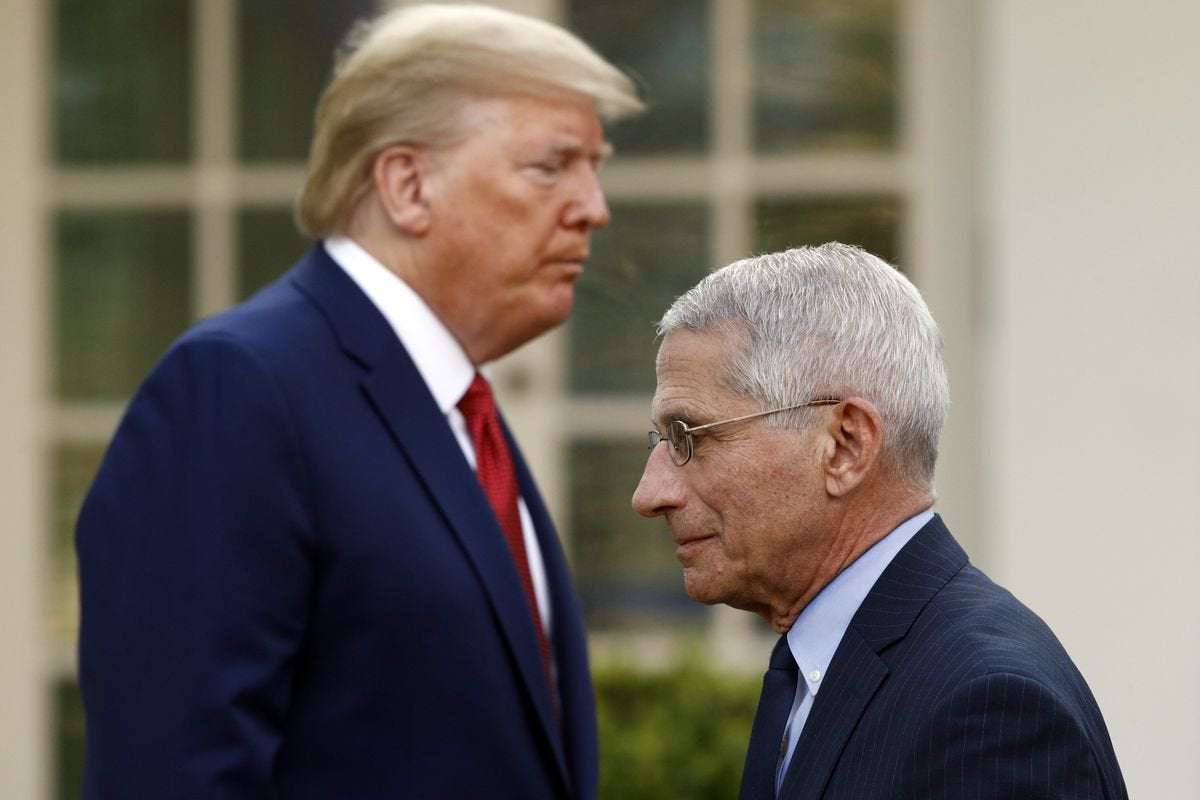Open this photo in gallery Dr. Anthony Fauci, director of the National Institute of Allergy and Infectious Diseases, walks from the podium as President Donald Trump returns to speak during a coronavirus task force briefing in the Rose Garden of the White House, Sunday, March 29, 2020, in Washington. Patrick Semansky/The Associated Press
When the U.S. sneezes, the old adage goes, Canada catches a cold.
But what happens when the U.S. coughs? When it coughs that dry hacking coronavirus cough?
The United States is now the epicentre of the global pandemic with more than 135,000 cases and 2,500 deaths, and counting.
Even Anthony Fauci, the level-headed director of the U.S. National Institute of Allergy and Infectious Diseases, warns that 100,000 to 200,000 Americans could die of COVID-19, the disease caused by the novel coronavirus.
In Canada, we have every reason to be alarmed. We could very well be on a similar trajectory.
Our two countries share the world’s longest non-militarized border, one that stretches 8,891 kilometres. More importantly, about two-thirds of all Canadians live within 100 kilometres of the border.
We can’t help but wonder if the mayhem that is being experienced by hospitals in New York State and nursing homes in Washington State – both of which are snuggled up against the Canadian border – will soon spill over.
In Canada, the common shorthand we use is taking U.S. statistics and dividing them by 10.
How many coronavirus cases are there in Canada, by province, and worldwide? The latest maps and charts
Coronavirus guide: The latest news on COVID-19 and the toll it’s taking around the world
Yet we don’t have one-tenth of the U.S. cases, 13,500, or deaths, 250. We have a little fewer than half those numbers, about 6,500 and 60.
Does that mean Canada is doing twice as well as the U.S. in response to the coronavirus? Or does it mean we’re doing half as much testing and wallowing in ignorance?
We’re probably doing a little bit better than the United States on social distancing because we got an earlier start. We also started testing earlier, but the U.S. has ramped up quickly and is testing far more aggressively.
Canada recorded its first case of novel coronavirus on Jan. 15. The U.S. saw its first case Jan. 20.
January seems like a decade ago now but it’s fair to say neither country acted with much urgency because the outbreak was still seen as one that was confined to China.
Still, the United States appointed a coronavirus task force. It was headed by Vice-President Mike Pence. Canada took a lower-key approach: Public health officials were in charge and politicians largely took a back seat.
Canada’s response, at least on the health side, has been neither politicized nor partisan.
In Canada, politicians have taken advice from public health officials and acted on it without much pushback. (On the economic side of the equation, it’s quite different. That is the bailiwick of politicians.)
In the U.S., President Donald Trump has, as always, insisted on taking centre stage. He routinely pushes aside and contradicts public health officials by saying, for example, that lockdowns should end soon and by touting unproven treatments. The President’s policy flip-flops are dizzying.
In contrast to Mr. Trump’s bombast, Canadian Prime Minister Justin Trudeau has been almost self-effacing. Seemingly worried at treading on provincial toes, he has emerged from self-isolation each morning largely to lob bromidic marshmallows about the importance of staying at home.
The other common problem our two countries have experienced is mixed messaging coming from provinces and states.
In the U.S., about 160 million people have “shelter in place” orders but in some states it’s business as usual. In Canada, it took 10 days for all the provinces and territories to declare states of emergency, and they all mean something slightly different.
What we don’t know is how well social distancing and self-isolation orders are being respected, and what difference they will make.
The American coronavirus testing debacle has been well-documented. The U.S. Centers for Disease Control and Prevention created a test but it didn’t work, and that cost public health officials almost a month.
Canada, for its part, started testing much earlier but ramped up very slowly.
The result is that, in both countries, it’s estimated that the real number of cases is five to 10 times the official number.
Ultimately, only time will tell how the two countries compare.
For Canada, the most frightening aspect of the U.S. outbreak is seeing how it has overwhelmed New York hospitals. U.S. hospitals have excess capacity; Canada’s tend to routinely operate overcapacity.
In Canada, we have a lot less wiggle room, and the ability of hospitals to withstand an influx of cases will be tested in the coming days.
First, we need to see if we can handle our own outbreak. Then we may have to deal with impact of the coughing monster next door.

Seevian on March 30th, 2020 at 18:05 UTC »
Is Trump still offering to set up soldiers on the border to stop people crossing illegally? I think we should take him up on it
Ziym on March 30th, 2020 at 16:19 UTC »
“China has no new cases”
“Taiwan and Hong Kong have new cases”
Big HMMMMMM right there
spidereater on March 30th, 2020 at 16:03 UTC »
I think the most immediate risk to Canada is shortages. Today essential items are still being manufactured and shipped. How many of these essential items come from the US? If sickness effects production and things run short will America still send items our way and have both countries make do with a bit of deprivation? Or will they stop exports and keep what’s produced for themselves? Hopefully the government is evaluating these scenarios and planning accordingly. If things get really bad there we will quickly see how close our countries really are.